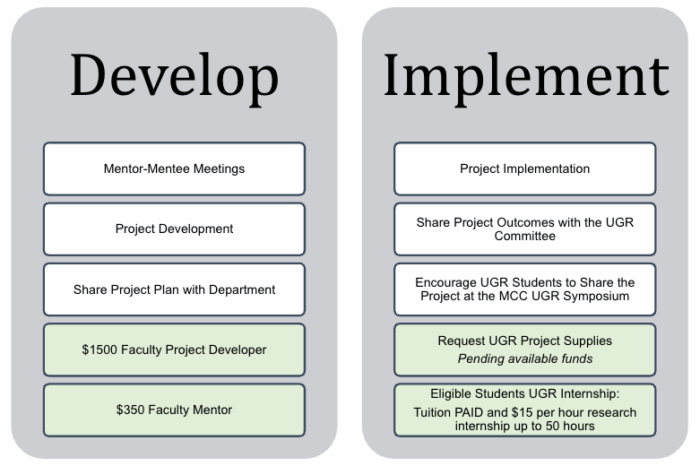Undergraduate Research Projects
According to the American Association of Colleges & Universities (2007), Undergraduate Research is included in a set of verifiable, effective educational practices that are correlated with positive educational results for students from widely varying backgrounds (see “High-Impact Educational Practices: A Brief Overview,”, pp.9-11). In connection with the AAC&U essential learning outcomes, Undergraduate Research fosters broad knowledge of human cultures and the natural world, strengthens intellectual and practical skills, and it is a practice of interactive and applied learning.
At Mesa Community College, Undergraduate Research Experiences occur in all disciplines. In this recorded presentation, Dr. Sara Brownell discusses what goes into developing, implementing, and assessing Course-based Undergraduate Research Experiences (CUREs).
MCC’s HSI-STEM: Guided Pathways Enhancement Project allocates funds for two types of research: Course-Based Undergraduate Research Experiences (CURE) and undergraduate research internships. Grant funds are available for:
- research project supplies,
- faculty development projects including faculty-faculty project development mentorship,
- hourly wages for grant-eligible students completing undergraduate research internships,
- tuition scholarship for grant-eligible students completing undergraduate research internships in a one-credit special projects course, and
- grant-eligible student and faculty travel funds for symposium awards.

MCC is a member of the Computing Alliance or Hispanic Service Institutions (CAHSI). Students that successfully complete CSC205AB and satisfy eligibility criteria may work with an MCC faculty mentor to complete the CAHSI Local Research Experience for Undergraduates (LREU). The LREU project may be blended with funding-eligible criteria for faculty development projects. Application cycles take place in the fall and spring terms.
What are Course-based Undergraduate Research Experiences?
Faculty integrate undergraduate research into regularly scheduled courses. The CURE projects are offered as an assignment option or a course requirement for all students. Students document the project by creating a research poster or similar documentation artifact.
What are Special Project Undergraduate Research Internships?
Faculty recruit students for undergraduate research internships to contribute to an original faculty-led or student-initiated research project. Students document the project by creating a research poster or similar artifact.
Faculty Undergraduate Research Development Projects
Projects are funded for faculty development during the fall, spring, and summer terms.

Develop a New Undergraduate Research Project
Approved faculty applicants that complete the items listed below will be eligible for a $1500 one-time payment.
- Complete the faculty development project application.
- Meet regularly with your assigned mentor and develop a project. CAHSI faculty may work with a CAHSI mentor.
- Course-based projects require all pages
- Research internship projects require pages 1-3
- Integrate a student research poster or similar documentation artifact as part of the project plan.
- Share the project plan with your department.
Update an Existing Undergraduate Research Project
Approved faculty applicants that complete the items listed below will be eligible for a $750 one-time payment.
- Complete the faculty development project application.
- Complete the project reflection and planning form. Contact the CTL for support.
- Course-based projects require all pages
- Research internship projects require pages 1-4
- Integrate a student research poster or similar documentation artifact as part of the project plan.
- Share the project plan with your department.
Implement an Undergraduate Reserch Project
- Special Projects Research Internship ONLY:
- Optional: Identify students that will enroll into the special projects course (Z formula funding applies).
- Grant-eligible students may qualify for undergraduate research hourly pay: Student interest form
- Use the mentor-mentee log to document faculty-student meetings
- Request project supplies.
- Implement the project.
- Share project outcomes with the MCC Undergraduate Research Committee.
- Encourage students to participate in the MCC Undergraduate Research Symposium.
Mentor Faculty Developing a New Undergraduate Research Project
Approved faculty mentors that complete the items listed below will be eligible for a $350 one-time payment.
- Submit the faculty-to-faculty mentor form.
- Determine if you will mentor faculty that are developing a course-based project or original research offered as a special projects course for research internships.
- Document regular meetings with your assigned mentee.
Funded by a U.S. Department of Education Title III HSI-STEM grant.
